| Author: | |
| Website: | |
| Page title: | |
| URL: | |
| Published: | |
| Last revised: | |
| Accessed: |
A chord is a line segment, the end points of which lie on a curve. From the point of view of studying trigonometry, we are primarily interested in chords whose end points lie on the circumference of a circle. The arc of the circle that lies between the two end points of the chord is said to be subtended by the chord. Both the arc, and the chord that subtends it, subtend the same central angle (i.e. the angle between the line segments connecting the ends of the chord and the centre of the circle). The relationship between a chord, the arc subtended by the chord, and the central angle subtended by the arc and the chord is illustrated below. In this diagram, we have adopted the convention used by the ancient Greeks, which is to label the central angle with the lower case Greek letter Alpha (α).
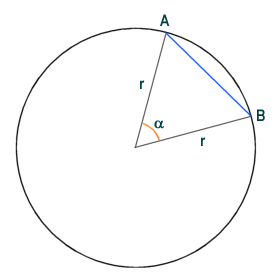
Chord AB subtends arc AB and central angle α
The branch of mathematics known as trigonometry began to emerge some three to four centuries BCE, as Greek astronomers and mathematicians searched for a consistent way of measuring and recording the movement and relative positions of various celestial bodies. One of the greatest problems they faced was how to accurately measure angles. It is evident from what we know of the writings of classical Greek mathematicians, such as Archimedes and Euclid, that the Greeks already had an extensive knowledge of geometry. This of course included knowledge of the properties of chords, and angles inscribed in a circle. Until the third century BCE, however, the theorems developed by the Greeks were presented in geometric rather than algebraic terms. Before we continue, there are a couple of things to keep in mind about chords of a circle:
The Greeks knew that the size of the central angle subtended by a chord of a circle is proportional to the ratio of the length of the chord and the diameter of the circle. They were certainly capable of constructing circles of a known diameter, and chords of a known length (you have probably done this at school with a pencil, a ruler and a pair of compasses). What they didn't have was a simple formula for calculating the size of the central angle subtended by a chord of known length (or vice versa). In fact, there isn't one. The trigonometric sine function is the modern equivalent of the Greek chord function (which we will talk about shortly). Your calculator can find the sine of an angle instantly, and with a high degree of accuracy. What you may not know, however, is that the microprocessor inside your calculator must run a highly complex algorithm in order to compute an accurate value. If you had to perform the necessary calculations by hand, it would take you a very long time.
In a very real sense, the chord function is all about the properties of a right-angled triangle inscribed in a semi-circle. The Greek chord function (usually written as crd) gives the length of the chord of a circle subtending a known central angle. If we were to implement the chord function in a computer programming language like C++, it would take as its arguments the size of the central angle α subtended by the chord, and the diameter d of the circle. The value returned by the function would be the length of the chord. In modern terms, it's the equivalent of taking the sine of half of angle α, and multiplying it by the diameter d of the circle. We can express this as follows:
| crd (α) = sin ( | α | ) d |
| 2 |
The problem for the Greeks was that they did not actually have an algorithm for implementing the chord function, just as they had no algorithm for finding the size of the central angle subtended by a chord of known length. There was no simple formula. For some central angles, the length of the chord subtending the angle can be found easily enough. In the most trivial case, for example, one hundred and eighty degrees (180°) is the angle subtended by the diameter of the circle (which is itself by definition a chord). The chords for other angles could be found by constructing inscribed regular polygons with different numbers of sides. The illustration below shows a simple example.
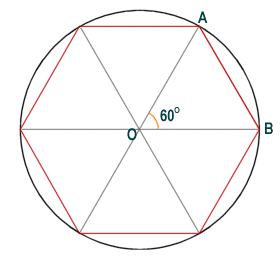
Each side of the hexagon subtends a central angle of sixty degrees
The inscribed polygon is a regular hexagon, each side of which is a chord that subtends a central angle of sixty degrees (60°). In triangle OAB, sides OA and OB are of equal length (being radii of the circle), and therefore angles OAB and ABO are equal. Since the internal angles of a triangle must add up to one hundred and eighty degrees (180°), angles OAB and ABO must both equal sixty degrees (60°), and triangle OAB is therefore an equilateral triangle. Chord AB is thus equal in length to the radius of the circle. A large number of constructions similar to the one shown above, often accompanied by complex calculations, would be required to find the chord lengths associated with a comprehensive range of angles.
Enter Hipparchus of Nicaea, whose life spanned much of the second century BCE. Hipparchus is considered by some historians to be the greatest astronomer of his time, although most of what we know about him is through the writings of later scholars. He spent most of his life on the island of Rhodes, where he set up his observatory. Much of his work involved determining and recording the latitude and longitude of stars in the celestial sphere. For this, he needed a table of trigonometric ratios. Since no such table existed at that time, Hipparchus set about creating his own. Hipparchus chose to divide the circle into three hundred and sixty equal parts, possibly borrowing the idea from Babylonian astronomy. He also used the Babylonian sexagesimal number system for his calculations, which were based on a circle with a fixed radius of 3438'.
The tick mark indicates that the number represents sixtieths, so in decimal terms this translates to 3438/60, or 57.3 (almost exactly the same value as the number of degrees in the radian of a circle, which is 360°/2π = 57.296°). The large value used for the radius meant that Hipparchus could achieve reasonably accurate results. The exact value was chosen because it meant that the length of the arc subtended by a central angle would be equal to (or very nearly equal to) the size of the angle itself. If that doesn't seem immediately obvious, remember that the Greeks knew that the circumference of a circle was equal to 2πr. So, for a radius of 3438/60, the circumference of the circle would be given as:
2π × 3438/60 = 21601.59/60 = 360.027
Obviously the chord of the circle will always be shorter than the arc it subtends, but for very small angles the difference would be marginal. For very small angles, therefore, Hipparchus could take the size of the angle itself as a reasonably accurate approximation of the length of the chord subtending the angle. The trigonometric tables compiled by Hipparchus did not survive, but are believed to have provided values of the chord function for all of the central angles between zero and one hundred and eighty degrees, in increments of seven and a half degrees, for a circle of radius 3438'. The values could be scaled up or down as required for circles of different radii.
A more complete table of chords is attributed to Claudius Ptolemy, a Greek-Roman citizen of Alexandria, Egypt. The table formed part of his most important work, a treatise on astronomy written during the second century CE. The work, which is thought to be based in no small part on the work of Hipparchus, is believed to have been more or less a summary of everything that was known about astronomy at that time, together with the mathematical theories underpinning this knowledge. Its original Greek title was later translated into Latin as Syntaxis Mathematica, although it is probably better known by the anglicised version of the name adopted for it by Arab scholars, which is Almagest.
Like Hipparchus, Ptolemy used a circle divided into three hundred and sixty parts, although he chose a diameter of one hundred and twenty units. Ptolemy's table of chords gave the value of the chord function for central angles ranging from half a degree up to one hundred and eighty degrees, in half degree steps. Each entry in the table included a value for the 'arc' of the circle subtended (i.e. the central angle in degrees), the 'chord' (i.e. the length of the chord subtending the arc, expressed as a sexagesimal number), and the 'sixtieths' (the amount to add to the length of the chord for each additional arcminute of angle subtended, also expressed as a sexagesimal number). Ptolemy calculated the 'sixtieths' by taking the difference between the 'chord' values for successive 'arcs', and dividing it by thirty, a simple but effective method known as linear interpolation. We have reproduced Ptolemy's table of chords for the first twenty-five arc values below. Note that we have added the decimal equivalent of the sexagesimal values to make the table a little easier to follow.
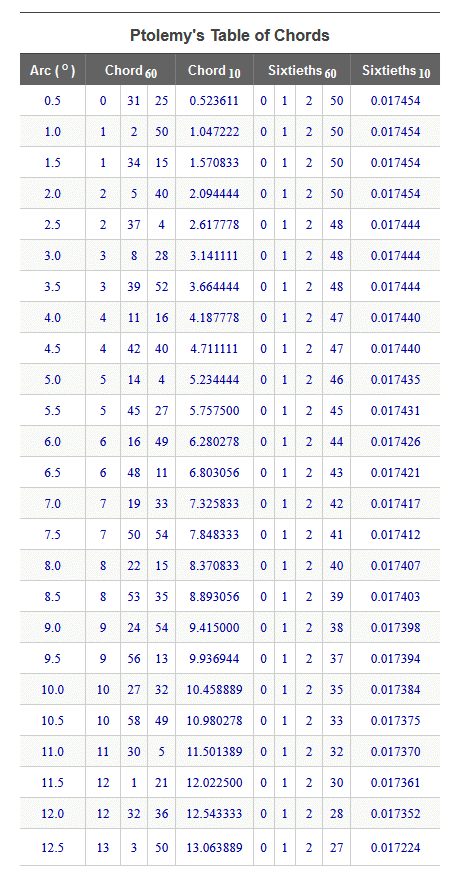
The first twenty-five values in Ptolemy's table of chords
It is uncertain how much of the work of Ptolemy was based on that of Hipparchus, but it is believed that Ptolemy initially followed Hipparchus' example by finding chords for larger angles as described earlier, namely by inscribing regular polygons in a circle and finding the length of the sides corresponding to chords of the circle. By inscribing three-, four-, five-, six- and ten-sided regular polygons in a circle, Ptolemy was able to find the chords for central angles of one hundred and twenty degrees (120°), ninety degrees (90°), seventy-two degrees (72°), sixty degrees (60°), and thirty-six degrees (36°) respectively. A chord corresponding to one side of an inscribed equilateral triangle, for example, would subtend a central angle of one hundred and twenty degrees (120°). So how would we go about finding the length of the chord (i.e. the side length of the inscribed triangle), assuming we have the same knowledge of geometry as the ancient Greeks and can't use trigonometry?
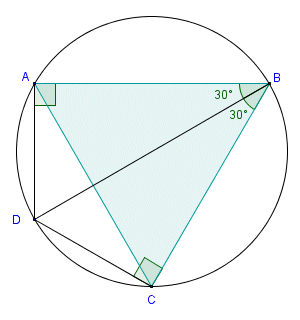
An equilateral triangle inscribed in a circle
The diagram above shows an equilateral triangle ABC inscribed in a circle. Line segment BD is the perpendicular bisector of chord AC. The perpendicular bisector of a chord must pass through the centre of the circle, and therefore line segment BD is a diameter of the circle (we will use the same value for the diameter as Ptolemy, namely 120 units). Since triangle ABC is equilateral, all of its internal angles are sixty degrees (60°). Line segment BD bisects angle ABC, so angles ABD and DBC are both thirty degrees (30°). Since line segment BD is a diameter of the circle, and since the angle subtended by a diameter at the circumference of a circle is always a right-angle, then angles DAB and BCD are both right-angles. Triangles DAB and BCD are therefore congruent, and chord CD is thus equal in length to chord DA.
So far, so good. We know the length of line segment BD (120 units), since it is a diameter of the circle. Our aim, however, is to find the length of one of the sides of the inscribed triangle. Ptolemy did this using the properties of an inscribed quadrilateral. Ptolemy's theorem (or at least, the theorem that is today commonly attributed to Ptolemy) states that the sum of the products of the opposite sides of a cyclic quadrilateral is equal to the product of its diagonals. The term cyclic quadrilateral simply means that the quadrilateral's vertices all lie on the circumference of the circle. We have a cyclic quadrilateral (ABCD) in our diagram above. We can therefore apply Ptolemy's theorem as follows:
AB · CD + BC · DA = AC · BD
But,
BC = AB, AC = AB
Therefore:
AB (CD + DA) = AB · BD
So:
CD + DA = BD
Since chords CD and DA are of equal length, they must both be sixty units long (remember that BD is the diameter of the circle, and therefore has a length of 120 units). We now know the length of two of the sides of right-angled triangle DAB, so we only need to apply Pythagoras' theorem to find the length of chord AB:
AB = √(BD2 - DA2)) = √(1202 - 602)) = √10800 = 103.923
So we now have a value for the chord subtending a central angle of one hundred and twenty degrees (103.923 units, accurate to three decimal places). Staying with our inscribed equilateral triangle for the moment, you may notice something else interesting. Chord DA subtends the central angle AOD, which is the supplementary angle to angle α (i.e. the angles sum to one hundred and eighty degrees). Angle AOD must therefore equal 180 - α. Since we know both the length of chord AD (sixty units) and the size of angle α (one hundred and twenty degrees), then the chord value for angle (180 - α), which in this case is sixty degrees (60°), must be sixty units. The principle is illustrated below.
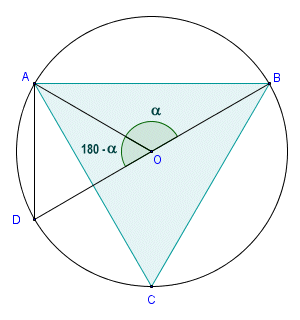
Chord DA subtends central angle (180 - α)
From the above, we can derive a relationship between any angle α and its supplementary angle (180 - α). Consider the illustration below.
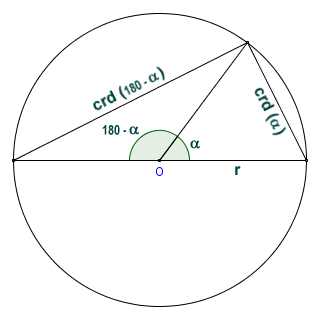
Angles α and (180 - α) are supplementary
The diameter of the circle forms the hypotenuse of a right-angled triangle for which crd (α) and crd (180 - α) are the two legs. Let's assume that we know the diameter of the circle, the length of crd (α) and the size of angle α. It is then a trivial matter to calculate the size of angle (180 - α). We can use Pythagoras' theorem to find the length of crd (180 - α) as follows:
crd (180-α) = √((2r)2 - crd2 (α))
Hence, once Ptolemy found the chord values for each half-degree increment from half a degree up to ninety degrees, finding chord values for the remaining half-degree increments (i.e. those between ninety degrees and one hundred and eighty degrees) was relatively straightforward, since the formula shown above could be used without the need for further geometric constructions. Bear in mind, however, that in an age before calculators or slide-rules, these calculations would still have represented a great deal of work. It is believed that Ptolemy, as well as many other mathematicians of ancient times, would have employed "computers". These were individuals who were hired to carry out the relatively time consuming and tedious work of actually performing the calculations by hand.
The chord subtending a central angle of ninety degrees (90°) is relatively trivial to find, since it forms the hypotenuse of a right-angled triangle in which both legs are radii of the circle, as shown below. The length of the chord is thus simply √2r.
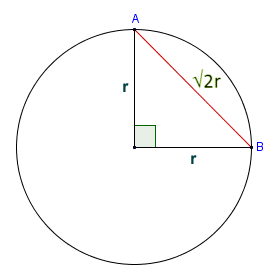
The chord subtending a central angle of ninety degrees = √2r
For the remaining chords values (i.e. those that could not be found using a suitable regular polygon inscribed in a circle) Ptolemy had to rely on a process of continued bisection and interpolation. Let's look at an example. In the diagram below, chord AB intersects a central angle of sixty degrees (60°) and its length is known. Similarly, chord AC subtends an angle of ninety degrees (90°), and its length is known. Chord BC therefore subtends an angle equal to the difference between the angle subtended by chord AB and the angle subtended by chord AC, which is thirty degrees (30°). If we can find the length of chord BC, we will have another entry for our chord table.
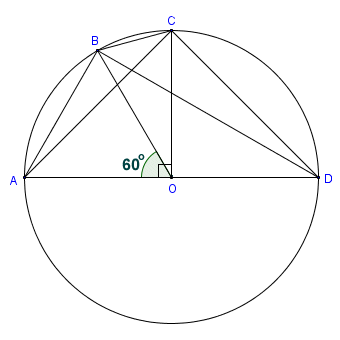
Chords AB and AC subtend central angles 60° and 90° respectively
Remembering Ptolemy's theorem, and using the cyclic quadrilateral ABCD, we have:
AB · CD + BC · DA = AC · BD
Rearranging gives:
BC · DA = AC · BD - AB · CD
Therefore:
| BC = | AC · BD - AB · CD |
| DA |
Ptolemy frequently chose cyclic quadrilaterals for which one of the sides was a diameter of the circle. This served to ensure that he always had enough information to carry out his calculations. Remember that we don't as yet know the lengths of chords BD and CD. We can use Pythagoras' theorem to obtain these values:
BD = √(DA2 - AB2)
and
CD = √(DA2 - AC2)
so,
| BC = | AC (√(DA2 - AB2)) - AB (√(DA2 - AC2)) |
| DA |
We now have a formula for finding the length of chord BC for which the values of all of the terms are known. Just to hammer the point home, let's put in some numbers and see what happens. We can get all of the values we need from the material we have looked at so far:
DA = 120 (diameter of the circle, chosen by Ptolemy)
AB = 60 (one side of an inscribed regular hexagon - see above)
AC = √2 × 60 = 84.853 (chord subtending a right-angle, see above)
BD = √(DA2 - AB2) = √10800 = 103.923
CD = √(DA2 - AC2) = √7199.968 = 84.853
As you may realise, from looking at these numbers and taking a closer look at the diagram, we didn't actually need to calculate the length of chord CD, since it subtends a central angle of ninety degrees (90°). It will therefore be the same length as chord AC, which also subtends a central angle of ninety degrees. Similarly, chord BD subtends an angle of one hundred and twenty degrees (120°), so it is the same length as one side of the inscribed equilateral triangle that we looked at earlier. Let's substitute these numbers into our original formula:
| BC = | (84.853 × 103.923) - (60 × 84.853) |
| 120 |
| BC = | 8818.178 - 5091.18 |
| 120 |
| BC = | 3726.998 |
| 120 |
BC = 31.058
Referring back to our version of Ptolemy's chord table (see above), the chord value for an arc of thirty degrees is given (in decimal form) as 31.058333. We have limited the numbers used in the above calculations to an accuracy of three decimal places, but the answer we got still matches the value given in the table. We can apply a similar principle to the sum of two angles. Consider the diagram below, in which all of the chords from which our cyclic quadrilateral is constructed, except one, subtend a central angle for which we already have a chord value.
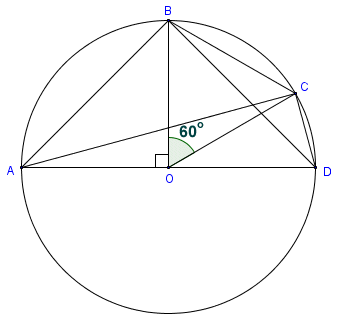
Chords AB and BC subtend central angles 90° and 60° respectively
If you look at diagonal AC of quadrilateral ABCD, you can see that it subtends a central angle of one hundred and fifty degrees (150°). We can easily deduce this from the fact that angle AOC is the sum of angles AOB (ninety degrees) and BOC (sixty degrees). We already have values for chords AB, BC and CD, which subtend central angles of ninety degrees (90°), sixty degrees (60°) and thirty degrees (30°) respectively. Chord DA is the diameter of the circle, and chord BD is equal in length to chord AB, since it subtends the same central angle. We just need to find the length of chord AC. Again, applying Ptolemy's theorem to the cyclic quadrilateral ABCD, we have:
AB · CD + BC · DA = AC · BD
Rearranging gives:
AC · BD = AB · CD + BC · DA
Therefore:
| AC = | AB · CD + BC · DA |
| BD |
Now let's list the known values:
DA = 120 (diameter of the circle)
AB = 84.853 (chord subtending 90°)
BC = 60 (chord subtending 60°)
BD = 84.853 (chord subtending 90°)
CD = 31.058 (chord subtending 30°)
Putting the numbers into the formula, we get:
| AC = | (84.853 × 31.058) + (60 × 120) |
| 84.853 |
| AC = | 2635.364 + 7200 |
| 84.853 |
| AC = | 9835.364 |
| 84.853 |
AC = 115.911
Our own reconstruction of Ptolemy's chord tables gives a value for the chord corresponding to a central angle of one hundred and fifty degrees as 115.911111, so again we have achieved a result that matches the numbers given in the table. Ptolemy's chord tables are generally believed to be accurate to six decimal places, which is no mean feat given the size of the task he undertook, and the fact that all of the calculations were carried out by hand. Of course, since we already have a value for crd (30), and since one hundred and fifty degrees is the supplementary angle of thirty degrees, we could just as easily find the value of crd (150) using the method described earlier, namely by constructing a right angled triangle inscribed in a half-circle in which these chords subtend supplementary central angles, as shown below.
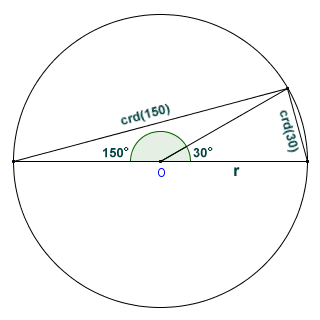
If we have a value for crd (30), we can find crd (150) using Pythagoras' theorem
Before we leave the subject of chords, there is one more interesting technique to look at, which involves the chord of half an arc. Consider the diagram below.
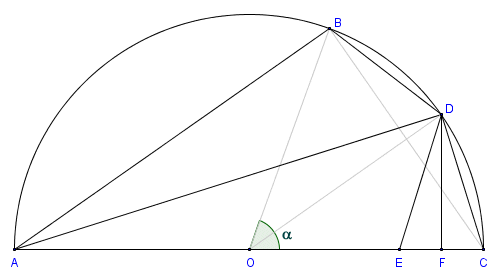
Chord BC subtends central angle α
In this construction, chord BC subtends angle α and its length is known. Chord AD bisects arc BC at point D. Line segment DF is perpendicular to diameter AC, and line segment AE is of equal length to chord AB. Chords BD and CD are equal in length, since they subtend arcs of equal length, and therefore they both subtend a central angle of 1/2 α. Since triangles BAD and EAD are congruent (AB = AE, side AD is shared, and angle BAD = angle EAD), line segment DE is equal in length to chord BD, and hence also to chord CD.
Since triangle DCE is isosceles (two sides of equal length), the perpendicular line segment DF must bisect the base of the triangle (line segment EC), and therefore line segments EF and CF are equal. Also, since line segment AE is equal in length to chord AB, line segment EC is equal to AC - AB, and line segment CF is therefore equal to 1/2 (AC - AB). Triangles ACD and DFC are similar (angle AFD = angle DFC = 90°, and angle ACD = angle FCD), so we have:
| AC | = | CD |
| CD | CF |
Cross multiplying gives:
CD2 = AC · CF
Remembering that CF is equal to 1/2 (AC - AB), we can write:
| CF 2 = | AC (AC - AB) |
| 2 |
Since we don't know the length of chord AB, we can apply Pythagoras' theorem:
| CD2 = | AC (AC-√(AC2 - BC2)) |
| 2 |
| CD = √ | AC (AC-√(AC2 - BC2)) |
| 2 |
To demonstrate that this works, let's put some real numbers into the equation. We will assume that angle α is seventy degrees (70°), which means that the angle subtended by chord CD will be thirty five degrees (35°). According to Ptolemy's table of chords, the length of the chord subtending a central angle of seventy degrees (i.e. chord BC), based on a circle of with a diameter of one hundred and twenty units, is 68.829 (to three decimal places of accuracy). We therefore have:
| CD = √ | 120 (120 - √(1202 - 68.8292)) |
| 2 |
| CD = √ | 120 (120 - √(14400 - 4737.431)) |
| 2 |
| CD = √ | 120 (120 - 98.298) |
| 2 |
CD = √1302.12 = 36.085
One of the advantages of using a diameter of one hundred and twenty units is that for relatively small angles, the length of the chord subtending the angle and the size of the angle itself are almost the same. Thus, even without checking Ptolemy's tables it is clear that our answer (36.085) must at least be in the right ball park. Remember that the angle for which we are seeking a chord length is thirty five degrees (35°). In fact, the chord value given in Ptolemy's table for thirty five degrees (converted to decimal) is 36.084722. This last application of Ptolemy's theorem is a little trickier to implement than the ones we saw earlier. It is very useful however, since it can be applied repeatedly to allow us to obtain chord values for very small angles.
Obviously, there are a number of techniques that Ptolemy could have used to find the chord values needed to complete his table. Now, nearly two thousand years later, it is difficult to be sure how much of the credit for the various methods used should go to Ptolemy, and how much should go to Hipparchus. It is probable that most of the underlying geometrical principles employed had been known about for centuries. Hipparchus, and later Ptolemy, applied that knowledge to the compilation of chord tables that would prove invaluable in the accumulation of astronomical data. In so doing, they laid the foundations upon which the branch of mathematics known to us today as trigonometry would be built.